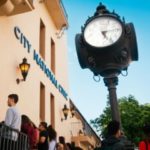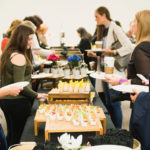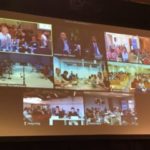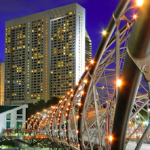Stuttgart is part of a natural tapestry of forests, valleys, and hills — green and sprawling, with a growing number of vineyards woven throughout. Not that the destination downplays its connection to cars. Mercedes-Benz and Porsche are both headquartered in Stuttgart, and in addition to manufacturing plants, the companies have built elaborate museums with event space in the heart of the city. And Messe Stuttgart, the 1.5-million-square-foot convention center, regularly hosts international automotive conferences and trade shows — including Automotive Testing Expo Europe 2016, held on May 31–June 2, which Convene attended as a guest of Stuttgart Convention Bureau.
Our visit also included an exclusive tour of Stuttgart that mixed venues and hotels with restaurants, parks, and other attractions. I came away with an impression of a lively, charming city that’s serious not just about meetings and events but also about sharing the culture of Swabia, the historic region in southwest Germany where it’s located.
ONE FINE DAY
For my visit, I flew into Frankfurt, then took a train from the airport to Stuttgart — a trip of about an hour and 20 minutes that was a snap, thanks to Germany’s easily navigable cross-country transit system. At Stuttgart Hauptbahnhof, the city’s main railway station, I was met by Karina Grützner, manager of business development for Stuttgart Convention Bureau and my host for the next few days, who escorted me to my first host hotel: Mövenpick Hotel Stuttgart Airport & Messe.
After checking in, it was off for a tour of the Mövenpick, a Green Globe–certified wonder of glass-sheathed geometry whose conference-friendly location places it directly between Stuttgart Airport and Messe Stuttgart — and within a short walk of both. The chic, professional property offers 326 guest rooms and suites, 16 meeting rooms, and a 6,070-square-foot ballroom. It’s also home to Trollinger, an elegant restaurant that specializes in contemporary Swabian cuisine. I opted for a local specialty: Schwäbischer Rostbraten — savory pan-fried steak with onions, served with a hearty portion of spaetzle.

The next morning, I walked over to Messe Stuttgart, where Automotive Testing Expo was winding down. The facility is striking, dominated by eight exhibition halls with high, gracefully swooping roofs and a capacity ranging from 288,500 square feet (in Hall 1) to 113,000 square feet (each in Halls 3–9). Hall 10 is under construction, slated for 157,000 square feet and a completion date sometime in 2018. There’s also the ICS International Congress Center Stuttgart, encompassing up to 33 conference rooms as well as 53,100-square-foot Hall C2. Most impressively, Messe Stuttgart wraps around Rothaus Park, a long, terraced green space that’s visible and accessible from pretty much anywhere thanks to the building’s ubiquitous floor-to-ceiling windows and glass doors.
A quick taxi ride took us to the outskirts of the city to visit Fernsehturm Stuttgart, an iconic 710-foot television tower. Built in 1956, and recently reopened after a three-year renovation project, the tower features an observation deck and a café with 360-degree views of the Stuttgart region — and is available for special events. For lunch in the tower’s Restaurant Leonhardts, I again went with something Swabian: Maultaschen, delectable ravioli-style pasta stuffed with meat, spinach, and onions.
Another taxi and we arrived at my second host hotel: Le Méridien Stuttgart. The stately brick-front property sits across the street from the Schlossgarten, a lovely green ribbon of a park that also runs in front of Stuttgart Hauptbahnhof. Le Méridien is an attractive option for group business, with 293 rooms and suites, and 14,400 square feet of event space — 13 conference rooms and the 4,700-square-foot Elysee Ballroom.

Then it was time for more cars. From Le Méridien, we walked to Stuttgart Hauptbahnhof and caught a train to the Porsche Museum. Located right next to Porsche headquarters, the museum is a statement in itself — an angular, bone-white slab, 75 feet tall, supported by three V-shaped pillars. Inside, visitors find more than 60,000 square feet of exhibits, including more than 80 vehicles, all telling the story of the world-famous sports-car company. Separate from that, the museum offers a 6,500-square-foot conference center on the fourth floor, plus an 8,600-square-foot rooftop terrace.
From there, it was back on the train, to Böblingen, just outside Stuttgart. Our destination: Motorworld, and even more cars. Really, all of the cars. Motorworld is a sort of four-wheel paradise, with displays of classic cars and motorbikes open to the public, space for owners and collectors to store their prized roadsters, dealer outlets, and, yes, nine themed conference rooms. It’s part of a complex built on the grounds of Böblingen Airport, which served Stuttgart from the 1920s through World War II. The V8 Hotel occupies the historic airport buildings, including the control tower, with 34 rooms and suites, 10 of them playfully decorated in a car theme. Also part of the complex: a hip restaurant called Check Inn, where I enjoyed a delicious Wiener Schnitzel, crunchy and tender, along with a crisp local pilsner. Sehr gut.
OLD AND NEW
It wouldn’t do to see just one of Stuttgart’s world-class automotive museums, so the next morning, we headed straight to the Mercedes-Benz Museum. Whereas Porsche chose a brash, daring design that fits its reputation as a speed-obsessed upstart, Mercedes-Benz went with something more sophisticated — as befits a company that traces its origins to Karl Benz’s creation of the gasoline-powered car in 1886. The museum’s exterior glows a soft, understated silver, while the interior is based on a double-helix — suggesting the DNA of innovation and invention — with no straight lines or right angles. Tour and exhibit paths spiral over nine stories, intertwining 160 vehicles and nearly 178,000 square feet of floor space. Event spaces are equally creative, from an outdoor theater that can accommodate 1,150 people, to a 3,000-square-foot space on the ninth floor offering stunning views of the city — not to mention various exhibit areas set against a fascinating backdrop of 130 years of automotive history.
Having traveled by taxi, train, and foot, it was time for a city bus, which took us to the Maritim Hotel Stuttgart, a classically beautiful property in the city center. The Maritim’s low-key intimacy belies the fact that it offers 555 guest rooms and suites, plus 13 conference rooms, the 3,600-square-foot Maritim Hall, and the 8,600-square-foot Reithalle, a handsome Italian Renaissance–style space built in 1885 as a horse-riding arena. The Maritim is directly connected to the Liederhalle, an expansive cultural and congress center that’s a gorgeous testament to post-war architecture and design, balancing Space Age minimalism with free-form curves and other organic flourishes. All told, the Leiderhalle encompasses five performance-caliber halls, from 3,600-square-foot, 320-seat Silcher Hall to 23,000-square-foot, 2,108-seat Beethoven Hall; and 18 conference rooms, ranging from nearly 200 to more than 1,000 square feet.
After a buffet lunch at the Maritim’s Rôtisserie restaurant, we had an afternoon to ramble, and so we did. From the Maritim and the Liederhalle, we headed through the Bosch Areal, a neighborhood that once was home to one of industrialist Robert Bosch’s factories, and today includes restaurants, bars, offices, and apartments — all bound together by an arcade-style glass ceiling. Over the next few hours, we toured the city center: the grand Haus der Wirtschaft (House of Commerce), built in 1896, and offering a variety of high-ceilinged, marble-floored event spaces; bustling Königstrasse, Stuttgart’s main shopping street and one of the busiest retail boulevards in Germany; enchanting Fluxus, a “temporary concept mall” meandering through an alley a few blocks off Königstrasse; Schlossplatz, the largest public square in Stuttgart, home to the 18th-century, Baroque-style Neues Schloss (New Castle); the Landesmuseum Württemberg, a historical museum occupying the 14th-century Altes Schloss (Old Castle); and much more.
We ended at Weinstube Kachelofen, a traditional Swabian wine bar popular with locals, where we sat outside and enjoyed the pleasant spring evening. This was my last night in Stuttgart, and I tried to make it count, sampling plates of delicious comfort food — sauerkraut, potato salad, bread and cheese, sausage salad, accompanied by a bright and satisfying local Riesling. My wine glass was local, too, and a little different, with a hand-formed green glass handle in place of a stem. It had a kind of sturdy beauty that reminded me of Stuttgart.



